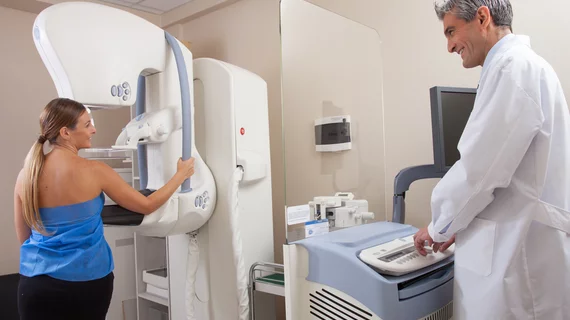Targeted US adds diagnostic insight for suspicious lesions found on contrast-enhanced mammography
Ultrasound can help clinicians improve their diagnosis of potentially cancerous lesions first detected on contrast-enhanced mammography, according to research published on Wednesday.
A team of doctors out of Memorial Sloan Kettering Cancer Center and Weill Cornell Medicine shared their perspective on utilizing targeted ultrasound to predict if suspicious breast lesions were malignant, Oct. 7 in AJR.
Overall, US and CEM findings correlated in 31% of cases and were more likely to be cancerous compared to lesions with non-concordant imaging, first author of the study Kristen Coffey, MD, with Kettering’s Department of Radiology, and colleagues noted.
Patients with concerning findings on CEM typically undergo a subsequent MRI for possible biopsy. But the authors said a US-guided approach may be an economical alternative.
“Although MRI-guided biopsy is now a relatively accessible modality, if a sonographic correlate to the MRI finding is identified, US-guided tissue sampling may be preferred as it is less expensive, more widely available, and more comfortable for the patient than MRI-guided biopsy,” Coffey and colleagues wrote, adding that CEM-specific biopsy systems are not yet commercially available.
The researchers looked over 1,000 consecutive CEM exams with same-day targeted breast US performed at a single organization between Oct. 2013 and May 2018. Of the 153 concerning lesions, 47 (31%) had a correlating ultrasound finding. Such lesions were more likely to be malignant compared to those without a corresponding ultrasound (26% versus 10%).
Distinguishing which lesions are likely cancerous from those seemingly benign may also eliminate the need for costly follow-up imaging, the authors explained.
“In our study, 21% of the US correlates had a benign or probably benign sonographic imaging appearance and did not need an MRI for further characterization; 7 of 10 such lesions were probably benign and underwent short-interval follow-up CEM and US wherein the benign impression was confirmed,” they added.
As it stands, CEM utilization is relatively low, for a number of reasons, but current literature supports its use in patients at intermediate risk of breast cancer who may not qualify for screening MRI.
“As the adoption of CEM continues to grow in the radiology community, CEM-directed US may be useful for further characterizing CEM lesions detected on screening and for potential biopsy planning, especially when MRI is not readily available,” Coffey et al. concluded.
Read the entire study in the American Journal of Roentgenology here.

